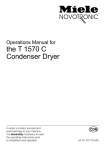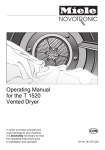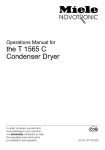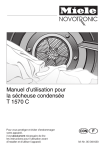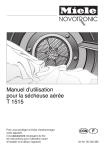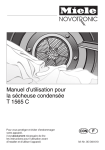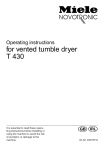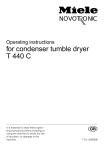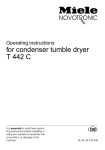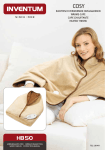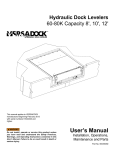Download Miele T1526 Operating instructions
Transcript
Operations Manual for the T 1526 Vented Dryer It is essential to read these operating instructions before installing or using the machine to avoid the risk of accident, or damage to the machine. ] M.-Nr. 05 017 940 Contents Contents Guide to the machine. . . . . . . . . . . . . . . . . . . . . . . . . . . . . . . . . . . . . . . . . . . . . . . 3 IMPORTANT SAFETY INSTRUCTIONS . . . . . . . . . . . . . . . . . . . . . . . . . . . . . . . . . 5 Your contribution to the environment . . . . . . . . . . . . . . . . . . . . . . . . . . . . . . . . . 7 Loading and unloading the machine . . . . . . . . . . . . . . . . . . . . . . . . . . . . . . . . . . 8 Notes on laundry care . . . . . . . . . . . . . . . . . . . . . . . . . . . . . . . . . . . . . . . . . . . . . . 9 Program selection Functional description . . . . . . . . . . . . . . . . . . . . . . . . . . . . . . . . . . . . . . . . . . . . . . To select a program . . . . . . . . . . . . . . . . . . . . . . . . . . . . . . . . . . . . . . . . . . . . . . . . To change a program during drying . . . . . . . . . . . . . . . . . . . . . . . . . . . . . . . . . . . Correct procedure . . . . . . . . . . . . . . . . . . . . . . . . . . . . . . . . . . . . . . . . . . . . . . . . . After the program has finished. . . . . . . . . . . . . . . . . . . . . . . . . . . . . . . . . . . . . . . . 10 11 11 11 11 Programs . . . . . . . . . . . . . . . . . . . . . . . . . . . . . . . . . . . . . . . . . . . . . . . . . . . . . . . 12 Cleaning and care . . . . . . . . . . . . . . . . . . . . . . . . . . . . . . . . . . . . . . . . . . . . . . . . 14 Problem solving guide. . . . . . . . . . . . . . . . . . . . . . . . . . . . . . . . . . . . . . . . . . . . . 15 After-sales service . . . . . . . . . . . . . . . . . . . . . . . . . . . . . . . . . . . . . . . . . . . . . . . . 18 INSTALLATION INSTRUCTIONS Grounding and Electrical connection . . . . . . . . . . . . . . . . . . . . . . . . . . . . . . . . . . 19 Installation . . . . . . . . . . . . . . . . . . . . . . . . . . . . . . . . . . . . . . . . . . . . . . . . . . . . . . . 20 Installation - venting . . . . . . . . . . . . . . . . . . . . . . . . . . . . . . . . . . . . . . . . . . . . . . . . 21 Technical data. . . . . . . . . . . . . . . . . . . . . . . . . . . . . . . . . . . . . . . . . . . . . . . . . . . . 26 Consumption data . . . . . . . . . . . . . . . . . . . . . . . . . . . . . . . . . . . . . . . . . . . . . . . . 27 2 Guide to the machine Guide to the machine 1 2 3 4 5 Supply cable with plug Control panel Drum door Exhaust connection (left or rear) Four height-adjustable legs 3 Guide to the machine Pushbuttons Indicator lamps – Door This button is used to open the door (does not stay pushed in). – PROGRAM SEQUENCE The program sequence indicator lamps show the current state of the drying program. – j ON / k OFF When the machine is turned on, the “On” indicator will light up if the door is closed. If the door is open, the drum light will be on. – Buzzer Allows the buzzer to sound when the drum rotates during the anti-crease cycle. – Low temp. Lower drying temperatures for delicate fabrics, e.g. acrylics (symbol r). – Start Starts the selected program (does not stay pushed in). – DRYING STAGE REACHED These indicator lamps show which drying stage the program has reached. For program stages “Normal” and “Extra dry” the indicator lamp remains at the “Normal” position. PROGRAM SETTING-SELECTOR Set the required program by turning the knob either clockwise or counterclockwise. – COTTONS – PERMANENT PRESS – TIMED DRYING Items can be either dried for 20 minutes (incl. a cooling-down phase) or cool air fluffed for 15 minutes. 4 IMPORTANT SAFETY INSTRUCTIONS IMPORTANT SAFETY INSTRUCTIONS WARNING - To reduce the risk of fire, electrical shock, or injury to persons when using your appliance, follow basic precautions, including the following: 1. Read these operating instructions before using your dryer for the first time, as this is for your own safety and for the protection of your machine. 2. Remember to remove the door when disposing of an old machine to prevent children from accidently locking themselves in the machine and endangering their lives. 3. Do not install or store this appliance where it will be exposed to the weather. 4. Do not install your dryer in rooms where freezing temperatures may occur. The reliability of the electronic control system may be impaired. 5. This machine should only be used for drying the following fabrics: 7. Clean the lint filter before and after each load. 8. Do not dry articles that have been previously cleaned in, washed in, soaked in, or spotted with gasoline, dry-cleaning solvents, other flammable or explosive substances as they give off vapors that could ignite or explode. 9. Do not allow children to play on or in the appliance. Close supervision of children is necessary when the appliance is used near the children. 10.To avoid back-pressure or accumulation of exhaust fumes, provide adequate room ventilation, by means of permanent vents or an open window. 11.Always close the door after use to prevent children from leaning on the door and causing the dryer to tilt. 12.Keep area around the exhaust opening and adjacent surrounding areas free from accumulation of lint, dust and dirt. – Items which can be machine dried as specified by the laundry care label. – Items which have been washed in water. 6. The following fabrics pose a fire hazard: – Items which contain foam rubber, rubber or rubberlike components. – Items which have been treated with inflammable cleaning agents, such as gasoline or dry-cleaning solvents. – Items containing hair lacquer, hairspray, nail polish remover or similar substances. 5 IMPORTANT SAFETY INSTRUCTIONS 13.The interior of the machine and exhaust duct should be cleaned periodically by qualified personnel. 14.Do not reach into the dryer if the drum is moving. 15.Do not tamper with controls. 16.Do not repair or place any part of the appliance or attempt any servicing unless specifically recommended in the user maintenance instruction or in published user repair instructions that you understand and have the skills to carry out. Repairs to electrical appliances should only carried out by qualified personnel. Incorrectly repaired machines may pose a considerable risk to the user. 17.Formation of lint. Lint is principally the result of friction when items are worn and washed. Machine-drying hardly causes any lint to form and, as has been established by reseach institutes, has no effect on the lifetime of fabrics. 18.Warning - Do not use fabric softener/anti static dryer sheets. Residues from these products blockup (clog) the lint filter causing premature failure of the dryer. Miele dryers are designed to dry laundry without static cling. However, should fabric softener be required, use liquid fabric softener in the wash cycle. Clean lint filter mesh monthly by washing/scrubbing with hot soap and water. 6 19.Do not place items exposed to cooking oils in your dryer. Items contaimed with cooking oils may contribute to a chemical reaction that could cause a load to catch fire. SAVE THESE INSTRUCTIONS For grounding and electrical connection instructions, refer to the electrical connection section. Your contribution to the environment Your contribution to the environment Disposal of the packing material. The transport and protective packing is mostly manufactured from the following recycled or re-useable materials: – corrugated paper/cardboard Disposal of your old machine. Old machines contain materials which can be recycled. Please contact your recycling center or scrap merchant and render the machine inoperative as per the “Important Safety Instructions” before disposing of the appliance. – polystyrene - CFC-free – polyethylene foil (transparent) – untreated wood – fiber board Please check local environmental regulations before disposing of packing materials and discarding the appliance. 7 Loading and unloading the machine Loading and unloading the machine WARNING - To reduce the risk of fire, electric shock, or injury to persons, read the IMPORTANT SAFETY INSTRUCTIONS before operating this appliance. Load the laundry loosely into the drum. Duvet covers and pillowcases should be fastened before drying in order to prevent small items from rolling inside of them. If the wash is not removed at the end of the drying program, the machine will automatically enter the anticrease cycle for 60 minutes. This entails the drum being rotated at short intervals in order to reduce the formation of creases. Once the laundry has been removed, check that the drum is empty. Any items left in the drum could be damaged through overdrying during the next program. Clean the lint filter after each drying cycle to prevent excessive energy consumption, longer program times and the risk of fire. The door should always be closed after use. Important: Check that laundry cannot be trapped by the door as this may cause damage to the fabric. 8 Notes on laundry care Notes on laundry care Before drying, check the instructions on the fabric care label. The following fabrics should not be dried in a tumble dryer: – Woollens and wool blends These fabrics tend to become matted and shrink. – Items filled with down The fine fabric interior tends to shrink, depending on the quality of the item involved. – Pure linen These items should only be machinedried if specified as suitable by the manufacturer on the textile care label. The surface of the fabric may otherwise tend to become “rough”. Miele dryers have been designed to dry laundry free of static cling, without the use of dryer softener sheets or similar products. The dryer continuously monitors the moisture content of the laundry, and automatically shuts off the heat when the selected degree of dryness is reached. Through the use of a cool down period, (where the machine operates without heat), cool, static free laundry is the end result. Dryer softener sheets perform the same function by depositing a chemical residue on both the clothes and the interior of the dryer. Over time, this coating may lead to performance reductions in the dryer. Notes: Knitted fabrics and flannel sheets tend to shrink when washed for the first time and also when dried. They should not be overdried (Extra dry)! Starched laundry can also be dried in the tumble dryer. Permanent press items should be briefly spun in the washing machine before drying. Items which are prone to creasing should not be dried in the “PERMANENT PRESS- Normal +” - Program. Drip-dry shirts made of pure cotton may tend to crease, depending on the quality of their finish. These items should be dried in a “Hand iron”program. Permanent press fabrics tend to crease more as the size of the load increases. This is particularly true of very delicate fabrics. The load should be reduced to 2 kg or, if necessary, to 1.5 kg. Do not dry new dark-colored fabrics together with light-colored items as they may discolor. If fabric softening is desired, it is more convenient, economical and beneficial to the clothing if a liquid softener is automatically dispensed while the clothes are in the washing machine. Please see the washing machine operating instructions for directions on how to automatically dispense a liquid softener. 9 Program selection Program selection Functional description An electronic sensor system monitors the moisture content of the laundry. Once the required degree of dryness is reached, cold air enters the drum to cool the laundry. The drying program is then terminated. Function of the pushbuttons – Low temp. When selected the machines lower drying temperatures for delicate fabrics, (e.g. acrylics, nylon). – Start Starts the selected program. “PROGRAM SEQUENCE” indicators The program sequence indicator lamps show the current status of the drying program. “DRYING STAGE REACHED” indicators This indicator shows which drying stage the program has reached. “PROGRAM SETTING” selector – Door This button is used to open the door. – ON/OFF When the machine is turned on, the “On” indicator lamp lights if the door is closed. When the door is open, the drum is illuminated. – Buzzer When depressed, the buzzer will sound as the drum rotates during the anticrease cycle. 10 There is a range of settings for both "Cottons" and "Permanent Press". In addition, items can be either dried for 20 minutes (incl. a cooling-cycle lasting 8 mins.) or fluffed in cool air for 15 minutes. Program selection To select a program Press the "On/Off" button. To change a program during drying Set the program selector to the desired program. The new program will start from the beginning. The tables on the following pages list the range of applications for the different programs. Set the desired program by turning the program selector either clockwise or counterclockwise. Press the "Start" button. The program status will be stored for 30 minutes in the event of a power failure. The program is canceled if: – There is a power failure lasting more than 30 minutes. – The door is opened after the machine has entered the "Cooling down" or "Anti-crease" stage. Correct procedure 1 Press the "On/Off" button. 2 Press the "Door" button. 3 Open the door and load the machine. 4 Close the door with a firm swing - do not push it shut. 5 If drying delicate fabrics, press the "Low temp." button. 6 Select the "Buzzer" if so desired. 7 Select a program. 8 Press the "Start" button. After the program has finished 1 Set the program selector to "Finish". 2 Remove the laundry. 3 Clean the lint filter. 4 Turn off the machine. 11 Programs Programs Drying stage Type of laundry/fabric Max. load Special instructions Multi-layer fabrics, mixed loads of cotton fabrics, e.g.jeans, towels, sweatsuits. Uniform loads of cotton fabrics e.g. flannel items, underwear, socks. 6 kg The “Extra dry” program should not be selected for jersey wear items or items that may shrink. If items are still damp, select the “Extra dry” program. Normal- Knitted cotton fabrics susceptible to shrinkage, e.g. jersey wear or lightweight cotton fabrics. 6 kg If items are still damp, select the “Normal“ program. Hand iron r Hand iron rr Cotton or linen fabrics, to be left damp for easier ironing. 6 kg Machine iron Cotton or linen fabrics, including starched laundry, to be ironed on the rotary iron, (B865E). 6 kg Moisture can be increased or decreased by using “Hand iron rr” or “Hand iron r” respectively. The laundry can be loosely rolled to prevent it from drying out until it can be ironed. COTTONS Extra dry Normal 12 6 kg Programs Drying stage Type of laundry/fabric Max. load Special instructions Permanent press items made of synthetic or blended fabrics, e.g. pullovers, dresses, pants, etc., which are not dried adequately in the “Normal” program. Permanent press shirts, table cloths, bedding etc. made of blended woven or knitted fabrics, e.g. cotton/synthetic. 3 kg With blended fabrics consisting of wool and synthetics, consult the manufacturer’s instructions, as the wool component may cause the fabric to matt and shrink. PERMANENT PRESS Normal + Normal 3 kg Permanent press shirts, table cloths, pillowcases etc. cotton/synthetics, which are to be pressed. 3 kg warm Individual items, e.g. comforters, or very small loads. - This cycle will run for the full 20 minutes, even if the clothes are dry sooner. cool air Items which you want to "fluff". 6 kg - Hand iron TIMED DRYING 13 Cleaning and care Cleaning and care Cleaning the lint filter The lint is collected by the lint filter in the door. Clean the filter after every program. Grip the filter by the recessed handle and pull up to remove. Cleaning the dryer Before cleaning the tumble dryer; disconnect the machine from the power supply. The dryer can be cleaned using soapy water or a mild detergent (not scouring powder) and dried with a soft cloth. The drum may be cleaned using a suitable stainless steel cleaner following the manufacturer’s instructions. The machine must never be hosed down. Do not use any abrasive substances or scouring pads to clean the machine. Any remaining lint in the hollow part of the door can be removed through the gap at the bottom. The lint filter can be rinsed with water if necessary. Dry the lint filter before putting it back in place. 14 Problem solving guide Problem solving guide Electrical appliances should only be repaired by qualified personnel. Incorrectly repaired machines may put the user at risk. There are, however, minor problems which can be corrected without contacting the Service Department. What to do if, . . . ? Cause . . . Remedy . . . . . . the tumble dryer fails to start when turned on? Check whether the “On” indicator lights up. If so, failure to start may be due to an incorrect program selection procedure. Repeat the switch-on procedure in the correct sequence, as outlined in the “Program Selection” chapter. If the “On” indicator lamp does not illuminate, check that: – The “ON/OFF” button is depressed. – The door is properly closed. – The machine is plugged in and the fuse or circuit breaker has not tripped. Select a longer drying program. . . . the laundry is not sufficiently dry? . . . the drying times are too long? . . . the “anti-crease” indicator lamp in the sequence indicator display starts flashing? The load consists of dissimilar items (size and fabrics). Small loads or individual items may cause the program to terminate the cycle prematurely. Small loads can be time-dried. The lint filter is clogged. Clean the lint filter in the door. The laundry was not spun in the washer for a sufficient time. Make sure that the laundry is thoroughly spun before drying. – Turn the program selector to “finish”. – Turn the machine off and then on again. – Select a program. – Press the “Start” button. If the indicator lamp starts flashing again, this indicates a fault in the machine. Please contact the Miele Service Dept. 15 Problem solving guide What to do if, . . . ? . . . the drum door opens during the drying cycle? . . . the interior drum light fails to function? . . . you have to open the door in the event of a power failure? 16 Cause . . . The machine has overheated. The temperature limiter opened the drum door and caused the machine to turn off automatically. Possible reasons for overheating: – The lint filter in the door is clogged. – The vent duct is blocked. – The vent aperture (e.g. louvred window vent, wall vent) is blocked. Remedy . . . It only lights up when the machine is switched on. The bulb may be burnt out. See next page. Before restarting the program, proceed as follows: – Release the ON/OFF button. – Clean the affected part of the machine. – Turn on the machine again. – Reselect the terminated program. – Press the “Start” button. If the drum door opens again, the Miele Service Dept. should be contacted. See next page. Problem solving guide The interior drum light fails to function: The bulb may be burnt out. To open the door in the event of a power failure Replace it as follows: Turn off the machine or disconnect it from the power supply. Open the door. Pull forward on the un-hinged side of the door. Unscrew the plastic bulb cover located inside the drum and above the door (see illustration). The light bulb must not exceed the maximum wattage quoted on the data plate. Replace the bulb and the plastic cover. The cover must be correctly installed and tightened, otherwise moisture may seep in and cause the socket to corrode. This is a temperature-resistant bulb and should only be ordered from your Miele Service Dept. 17 After-sales service After-sales service In the event of problems which cannot be solved, please contact: – Your Miele Dealer – The nearest Miele Service Department (see back cover for the adress). When contacting the Service Department, please quote the Model and Serial numbers of your appliance, both of which can be found on the right side after the door is opened. Specimen: 18 INSTALLATION INSTRUCTIONS INSTALLATION INSTRUCTIONS Grounding and Electrical connection Grounding instructions This appliance must be grounded. In the event of a malfunction, grounding will reduce the risk of electric shock by providing a path of least resistance for the electric current. This appliance is equipped with a cord having an equipment grounding conductor and a grounding plug. The plug must be plugged into an appropriate outlet that is properly installed and grounded in accordance with all local codes and ordinances. Warning Improper connection of the equipment-grounding conductor can result in a risk of electric shock. Check with a qualified electrician or serviceman if you are in doubt as to whether the appliance is properly grounded. Do not modify the plug provided with the appliance; if it will not fit the outlet, have a proper outlet installed by a qualified electrician. Electrical connection This installation should be done by an experienced and qualified person, in most cases a licensed electrician, in accordance with local codes and regulations. This dryer is supplied with a 1.5 m power cord with a 3-pole, 4 wire grounding plug, 14-30P (regular Canadian dryer plug). This plug has to be plugged into a 3-pole, 4 wire grounding receptacle, 14-30R (regular Canadian dryer receptacle). The receptacle has to be connected to Line 1, Line 2, Neutral and Ground wires. The voltage is 120/240 V AC or 120/208 V AC. “EASY INSTALLATION KIT” If you do not have a designated line, 4 wire, 120/240 V – 15 or 30 Amps, for this appliance, but you have the 4 wire, 120/(208)240 V – 30 Amp Canadian dryer wall receptacle (14-30 R) you can use the Miele Double Receptacle Box. This consists of two standard receptacles 14-30 R, 4 fuses, box and plug cord, which allows you to use that single dryer wall receptacle to supply power to a Miele washer and Miele dryer. Both machines may operate at the same time because each uses maximum about 15 A current. For more information on the electrical connection on the Miele Double Receptacle Box please contact: – your Miele dealer – the nearest Miele Service Department. 19 INSTALLATION INSTRUCTIONS Installation Turn the counternuts up and tighten against the bottom. A gap of 10 mm must be maintained between the bottom of machine and the floor. This gap must not be blocked by deep pile carpet, plinths etc., as this will prevent a sufficient intake of cold air. Where to install the machine The space required by the vent duct should be taken into consideration when calculating the distance between the machine and a wall or other appliances. The machine should be level to ensure safe and proper operation. Minor discrepancies do not, however, have an adverse effect on operation. The tumble dryer can also be placed on top of a Miele washing machine (capacity 6 kg) for a stacked installation. An appropriate stacking kit is required and can be obtained from your Miele dealer, or the Miele Parts Dept. The machine can be leveled by turning the legs clockwise or counterclockwise as necessary. 20 INSTALLATION INSTRUCTIONS Exhaust venting The moist air from the dryer must be vented to the outside. Installing the connector on the left side of the machine Remove the cap covering the exhaust part as follows: The appliance should not be vented into a chimney, a wall, a ceiling, or any concealed spaces of the building. When installing, try to avoid: – very long venting systems – too many bends or angles – tight corners otherwise . . . . . . the drying results will be affected, . . . drying will take longer and use more energy. Materials suitable for venting: – rigid metal pipe – flexible metal pipe Install the venting in such a way that the expelled air cannot be drawn back into the machine. – Insert a thin screwdriver into the slot by the retaining hook. Press the hook gently upwards. At the same time turn the cap counterclockwise. Do not vent the dryer into a flue used by gas or fuel boilers or heaters. A vent connector is included with the machine. It should be pressed into the vent outlet and will simplify the connection of the exhaust pipe. Before installation, disconnect the tumble dryer from the electrical supply (unplug from the wall socket, or turn off the circuit breaker. Installation at the rear The machine comes supplied with the connector installed on the rear exhaust port. In the same way remove the vent socket from the rear exhaust port. Secure into the side port by pressing it in and turning it clockwise. Seal the rear exhaust port using the cap. 21 INSTALLATION INSTRUCTIONS The shorter the exhaust ductwork, the more efficient the dryer will be. Expelled air is slowed down in the ducts due to friction against the inner walls, therefore the shorter and smoother the inner walls are, the less friction will occur. An elbow or bend creates more friction than a straight duct. An additional duct length factor must therefore be added for each elbow or bend (see Table I). This factor expresses the resistance of the bend in terms of a straight length of duct. The additional length factor is then added to the measured duct length to give the effective duct length. A larger duct diameter also helps to reduce friction. The duct diameter should therefore be increased with increasing duct length. To calculate the effective duct length. Measure the actual duct length. Establish the number of elbows or bends necessary, noting the type of bend, angle and radius involved (see Table I). Add the additional length factor as specified in Table I to the actual duct length to give the effective duct length. The necessary duct diameter should then be found in Table II. Note: Drying times and energy consumption remain unaltered for 100 mm duct up to a total length of 8 m. Longer duct may lead to slight increases in drying times and energy consumption but will not impair the function of the machine as long as the necessary duct diameter is used (see Table II). Tabel I Type of bend Flexible metal piping Plain piping Elbow Concertina bend Wall vent kit with louvres, or window vent kit Wall vent kit with flap, or window vent kit Exhaust connection, left side 22 Angle Radius in mm 90° 90° 45° 90° 100-300 300-500 100-500 100 90° 200 Additional duct length in m 0.5 0.3 0.3 0.35 2.3 0.7 3.6 1.25 4,9 INSTALLATION INSTRUCTIONS Table II Effective duct length (m) 0-8 8-12 12-17 17-23 23-31 31-41 Example: Internal diameter or edge length (mm) 100 110 120 130 140 150 Flexible ducting has been used for the following example. Exhaust connection, left . . . . . . . 4.9 m Length (L) . . . . . . . . . . . . . . . . . . 1.2 m Lower radius (R = 400 mm) . . . . 0.5 m Height (H) . . . . . . . . . . . . . . . . . . 1.2 m Upper radius (R) . . . . . . . . . . . . . 0.5 m Wall pipe with louvred vent . . . . . 3.6 m Effective duct length . . . . . . . . . 11.9 m Result: A duct diameter of 110 mm is adequate since the effective length is less than 12 m as specified in Table II. 23 INSTALLATION INSTRUCTIONS Moist air can be ducted outside by a wall vent or window vent, both of which are available from most hardware stores. Window vent kit - example Wall vent kit - example 1. Louvred wall vent frame 2. Wall vent duct 3. Adapter 4. Louvred wall vent 5. Flap 6. Screw 7. Wall anchor 1. Louvred window vent frame 4. Louvred window vent 5. Flap 8. Clips (4 pcs.) 9. Raised head screws (4 pcs.) Dryer-side view: 1. Window vent kit 2. Adapter for vent duct Dryer-top view: 1. Wall pipe 2. Flexible foam-gasket A flexible foam gasket must be used if the tumble dryer is directly connected to the wall vent. 24 The window vent kit is installed into in a plexiglass pane. If using an existing glass pane, cut a hole with a diameter of 125 mm. INSTALLATION INSTRUCTIONS Fig. 1 Ducting (side view) with flexible vent hose to an exhaust flue. 1. Wall vent duct A. Wire spiral-wound hose 2. Adapter B. Flexible ducting 3. Flue isulated against damp Fig. 2 Ducting (side view) with plastic piping to a wall vent kit. Fig. 3 Connection of piping to the tumble dryer. 1. Drain pipe 2. Adapter for vent duct between tumble dryer and plastic drain pipe Fig.4 Height of vent outlet for washer dryer stack. 1. Wall vent kit 2. Adapter 3. Drain pipe (outer dia. 110 mm) 25 Technical data Technical data Height. . . . . . . . . . . . . . . . . . . . . . . . . . 85 cm (adjustable +1/-0.5 cm) Width . . . . . . . . . . . . . . . . . . . . . . . . . . 59.5 cm Depth (incl. distance from wall) . . . . . . 70 cm Weight . . . . . . . . . . . . . . . . . . . . . . . . . 57 kg Drum volume . . . . . . . . . . . . . . . . . . . . 126 l Capacity . . . . . . . . . . . . . . . . . . . . . . . . 6 kg dry laundry Rated load . . . . . . . . . . . . . . . . . . . . . . See Data Plate Fuse rating . . . . . . . . . . . . . . . . . . . . . . See Data Plate 26 Consumption data Consumption data load Final spin speed in washer* Electrical consumption kg rpm kwh Drying time incl. cooling down time mins Extra dry 6 1200 1400 1600 3.65 3.50 3.20 92 89 81 Normal 6 1200 1400 1600 3.15 3.00 2.70 82 79 71 Normal- 6 800 (70 % residual moisture) 1200 1400 1600 3.85 3.00 2.85 2.55 98 79 75 68 Hand iron rr 6 800 (70 % residual moisture) 1200 1400 1600 3.10 2.25 2.10 1.80 82 63 59 52 Machine iron 6 1200 1400 1600 1.80 1.65 1.35 52 48 41 Cottons Permanent Press Normal + 3 1000 1.49 44 Normal 3 1000 (50 % residual moisture) 1.40 41 Hand iron 3 1000 1.20 37 The specified program running times and electrical consumption values were established under standard conditions (EN 61121/A11). Different types of fabrics, load size and residual moisture after spinning may effect the specified values. *These values apply if the laundry is spun in a Miele washing machine before drying. 27 All rights reserved/001 3498 This paper is made from 100% chlorine-free bleached cellulose and therefore protects the environment.




























